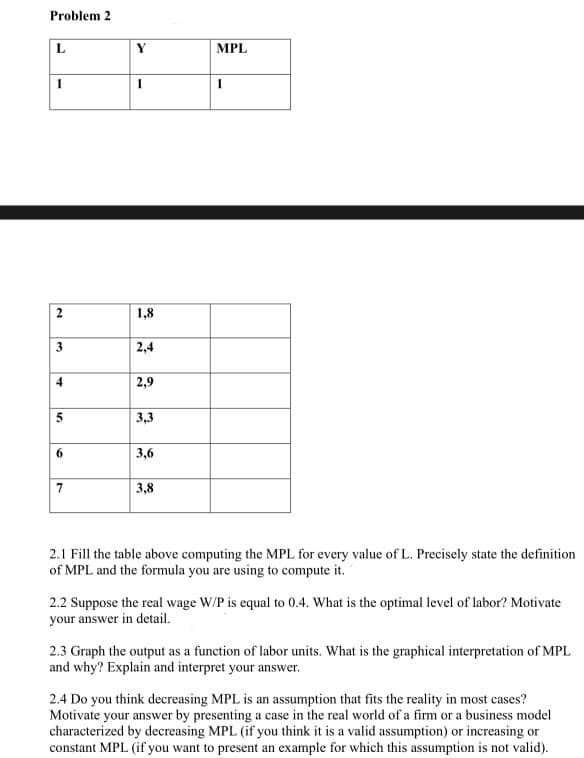Problem 2 Y MPL 1,8 3 2,4 2,9 3,3 6. 3,6 7 3,8 2.1 Fill the table above computing the MPL for every value of L. Precisely state the definition of MPL and the formula you are using to compute it. 2.2 Suppose the real wage W/P is equal to 0.4. What is the optimal level of labor? Motivate your answer in detail. 2.3 Graph the output as a function of labor units. What is the graphical interpretation of MPL and why? Explain and interpret your answer. 2.4 Do you think decreasing MPL is an assumption that fits the reality in most cases? Motivate your answer by presenting a case in the real world of a firm or a business model characterized by decreasing MPL (if you think it is a valid assumption) or increasing or constant MPL (if you want to present an example for which this assumption is not valid). 2. 4.
Problem 2 Y MPL 1,8 3 2,4 2,9 3,3 6. 3,6 7 3,8 2.1 Fill the table above computing the MPL for every value of L. Precisely state the definition of MPL and the formula you are using to compute it. 2.2 Suppose the real wage W/P is equal to 0.4. What is the optimal level of labor? Motivate your answer in detail. 2.3 Graph the output as a function of labor units. What is the graphical interpretation of MPL and why? Explain and interpret your answer. 2.4 Do you think decreasing MPL is an assumption that fits the reality in most cases? Motivate your answer by presenting a case in the real world of a firm or a business model characterized by decreasing MPL (if you think it is a valid assumption) or increasing or constant MPL (if you want to present an example for which this assumption is not valid). 2. 4.
Chapter1: Making Economics Decisions
Section: Chapter Questions
Problem 1QTC
Related questions
Question
2.3 and 2.4

Transcribed Image Text:Problem 2
L
Y
MPL
1
1
1,8
3
2,4
2,9
3,3
6.
3,6
3,8
2.1 Fill the table above computing the MPL for every value of L. Precisely state the definition
of MPL and the formula you are using to compute it.
2.2 Suppose the real wage W/P is equal to 0.4. What is the optimal level of labor? Motivate
your answer in detail.
2.3 Graph the output as a function of labor units. What is the graphical interpretation of MPL
and why? Explain and interpret your answer.
2.4 Do you think decreasing MPL is an assumption that fits the reality in most cases?
Motivate your answer by presenting a case in the real world of a firm or a business model
characterized by decreasing MPL (if you think it is a valid assumption) or increasing or
constant MPL (if you want to present an example for which this assumption is not valid).
Expert Solution
This question has been solved!
Explore an expertly crafted, step-by-step solution for a thorough understanding of key concepts.
Step by step
Solved in 4 steps with 1 images

Knowledge Booster
Learn more about
Need a deep-dive on the concept behind this application? Look no further. Learn more about this topic, economics and related others by exploring similar questions and additional content below.Recommended textbooks for you


Principles of Economics (12th Edition)
Economics
ISBN:
9780134078779
Author:
Karl E. Case, Ray C. Fair, Sharon E. Oster
Publisher:
PEARSON

Engineering Economy (17th Edition)
Economics
ISBN:
9780134870069
Author:
William G. Sullivan, Elin M. Wicks, C. Patrick Koelling
Publisher:
PEARSON


Principles of Economics (12th Edition)
Economics
ISBN:
9780134078779
Author:
Karl E. Case, Ray C. Fair, Sharon E. Oster
Publisher:
PEARSON

Engineering Economy (17th Edition)
Economics
ISBN:
9780134870069
Author:
William G. Sullivan, Elin M. Wicks, C. Patrick Koelling
Publisher:
PEARSON

Principles of Economics (MindTap Course List)
Economics
ISBN:
9781305585126
Author:
N. Gregory Mankiw
Publisher:
Cengage Learning

Managerial Economics: A Problem Solving Approach
Economics
ISBN:
9781337106665
Author:
Luke M. Froeb, Brian T. McCann, Michael R. Ward, Mike Shor
Publisher:
Cengage Learning

Managerial Economics & Business Strategy (Mcgraw-…
Economics
ISBN:
9781259290619
Author:
Michael Baye, Jeff Prince
Publisher:
McGraw-Hill Education